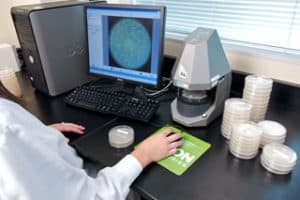The Ames Mutagenicity test is used to determine the potential mutagenic activity of an extract from a medical device/material. The Bacterial Reverse Mutation Assay (Ames test) is performed as part of the genotoxicity battery of tests to determine if leachables from a medical device/material are mutagenic.
This test complies with the OECD and ISO guidelines as one of the three levels of in vitro tests for genotoxicity and follows the AAMI/ANSI/ISO/10993-3, AAMI/ANSI/ISO/10993-1, AAMI/ANSI/ISO/10993-12, and OECD 471 standards.
Download the biocompatibility test matrix. [Based on ISO 10993-1:2010 (E) and FDA “Use of international standard ISO 10993-1”]
Applicable Standards
- AAMI/ANSI/ISO 10993-3
- OECD 471
- ASTM E1687
- ANSI/AAMI/ISO 10993-12
Sample Specifications
GTX110: 4 complete devices, each >60 cm2 or 2 grams
GTX150: 10 mL
Study Outline
The Ames Mutagenicity test employs several strains of Salmonella typhimurium which have been selected based on their sensitivity to mutation because of:
- An increased cell wall permeability due to a mutation which causes partial loss of the lipopolysaccharide barrier that coats the bacterial surface, resulting in increased permeability to large molecules (rfa mutation)
- A mutation in the bacterial cell system which excises and repairs defects in the DNA, resulting in the inability to repair damaged or mutated sections (uvrB mutation)
- R-factor plasmids (some strains) and a multicopy plasmid (some strains) which contain error-prone DNA repair systems
The tester strains also require histidine for growth, due to a mutation in the gene which controls production of histidine.
The tests are performed by mixing an extract of the test article with the test organism in a soft agar solution, which contains only small amounts of histidine. The histidine permits the inoculated test organism to undergo a limited number of divisions, but is insufficient to permit normal growth.
If, however, the strain undergoes a reverse mutation (spontaneous or induced by the test substance or a positive control material), the organism no longer requires histidine to grow and can produce a visible colony or revertant. Only mutations to the test organism in the region of the histidine gene will cause the test organism to undergo a reverse mutation to an organism, which then no longer requires histidine.
Tester strains are selected to detect various types of mutagens. The tester strains employed are TA97A, TA98, TA100, TA102, and TA1535.
A spot test is also performed in which the extracts of the test article are spotted on a plate containing the test organism with a small amount of histidine. As the test substance diffuses through the agar, it becomes more dilute. This allows for detection of mutagens which cause some inhibition of the tester strains. The tests are performed both with and without S-9 activation. The S-9 activation system is designed to simulate mammalian liver enzyme systems and is used to detect substances which undergo metabolic activation from non-mutagenic forms.



